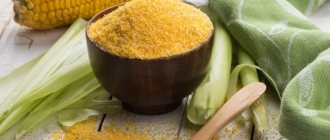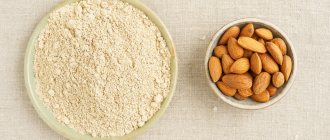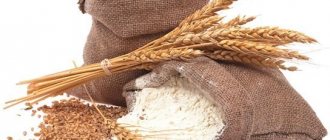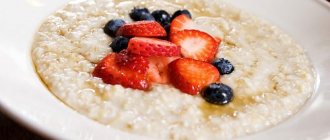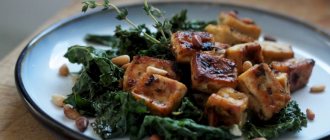Nutritional value and composition of buckwheat bread
Buckwheat bread contains a number of vitamins, namely: B1, B2, B5, B9, B6, A, E, PP, as well as minerals such as calcium, potassium, zinc, magnesium, cobalt, molybdenum, selenium, fluorine, copper, iron, manganese, sodium and phosphorus.
100g of buckwheat bread contains:
- Proteins – 7.1.
- Fats – 2.5.
- Carbohydrates – 45.8.
- Kcal – 228.
Buckwheat bread is part of the diet of vegetarians and those who play sports and lead an active lifestyle. This bread is recognizable by its aroma and taste, it is slightly moist, with a crispy crust, the taste is buckwheat and nutty, due to the fact that the flour is made from fried buckwheat.
Useful properties of buckwheat bread
By eating buckwheat bread, a person provides himself with a complex of vitamins and minerals that are contained in buckwheat and wheat flour.
The chemical composition of this bread is rich in calcium, cobalt and iodine.
Buckwheat bread is a complex of carbohydrate compounds that provide the body with the energy necessary for an active lifestyle.
Calorie content of buckwheat bread. Chemical composition and nutritional value.
Nutritional value and chemical composition of “buckwheat bread”.
The table shows the nutritional content (calories, proteins, fats, carbohydrates, vitamins and minerals) per 100 grams of edible portion.
| Nutrient | Quantity | Norm** | % of the norm in 100 g | % of the norm in 100 kcal | 100% normal |
| Calorie content | 228 kcal | 1684 kcal | 13.5% | 5.9% | 739 g |
| Squirrels | 7.1 g | 76 g | 9.3% | 4.1% | 1070 g |
| Fats | 2.5 g | 56 g | 4.5% | 2% | 2240 g |
| Carbohydrates | 45.8 g | 219 g | 20.9% | 9.2% | 478 g |
| Alimentary fiber | 2.8 g | 20 g | 14% | 6.1% | 714 g |
| Water | 9 g | 2273 g | 0.4% | 0.2% | 25256 g |
| Ash | 1.5 g | ~ | |||
| Vitamins | |||||
| Vitamin B1, thiamine | 0.4 mg | 1.5 mg | 26.7% | 11.7% | 375 g |
| Vitamin B2, riboflavin | 0.18 mg | 1.8 mg | 10% | 4.4% | 1000 g |
| Vitamin E, alpha tocopherol, TE | 0.3 mg | 15 mg | 2% | 0.9% | 5000 g |
| Vitamin RR, NE | 6.3 mg | 20 mg | 31.5% | 13.8% | 317 g |
| Niacin | 3.1 mg | ~ | |||
| Macronutrients | |||||
| Potassium, K | 130 mg | 2500 mg | 5.2% | 2.3% | 1923 |
| Calcium, Ca | 42 mg | 1000 mg | 4.2% | 1.8% | 2381 g |
| Magnesium, Mg | 48 mg | 400 mg | 12% | 5.3% | 833 g |
| Sodium, Na | 3 mg | 1300 mg | 0.2% | 0.1% | 43333 g |
| Phosphorus, Ph | 250 mg | 800 mg | 31.3% | 13.7% | 320 g |
| Microelements | |||||
| Iron, Fe | 4 mg | 18 mg | 22.2% | 9.7% | 450 g |
| Digestible carbohydrates | |||||
| Starch and dextrins | 70.2 g | ~ | |||
| Mono- and disaccharides (sugars) | 1.4 g | max 100 g | |||
| Saturated fatty acids | |||||
| Saturated fatty acids | 0.2 g | max 18.7 g |
The energy value of buckwheat bread is 228 kcal.
Primary Source: Created in the application by the user. Read more.
** This table shows the average levels of vitamins and minerals for an adult. If you want to know the norms taking into account your gender, age and other factors, then use the “My Healthy Diet” application.
Buckwheat bread recipe
A healthy and tasty product can be prepared at home in the oven.
Recipe 1. Yeast-free buckwheat sticks in the oven.
Ingredients:
- buckwheat – 1 tbsp.;
- oatmeal – ½ cup;
- salt - to taste;
- water (how much dough will take).
Preparation:
- Grind buckwheat and oatmeal using a blender to flour.
- Add a little salt for taste.
- Pour in water. The mass should be thick and not stick to your hands. You need just enough water to form sticks.
- Place the products on a baking sheet lined with parchment paper.
- Bake for about 30 minutes until done.
Recipe 2. Boiled buckwheat bread
Ingredients:
- boiled buckwheat – 1 tbsp.;
- milk – 200 ml;
- flour – 1 tbsp.;
- egg – 1 pc.;
- yeast – 1 tsp;
- sunflower oil (olive oil is possible) – 3 tbsp. l.;
- salt - a pinch.
Preparation:
- Prepare the dough: pour yeast into heated milk, stir, sift 2 tbsp. l. flour, leave for 15 minutes.
- Add boiled buckwheat to the dough, beat the egg, add salt and mix.
- Add butter, sifted flour, knead until smooth.
- Leave the dough for 1 hour in a warm, dry place.
- “Dip” the risen dough and roll it out to about 1 cm thick. Cut out circles using a glass.
- Transfer them to a baking sheet lined with parchment.
- Bake for 20 minutes until browning at 185 - 190 degrees.
Homemade buckwheat breads are just as tasty and healthy as store-bought ones.
How to cook at home?
Buckwheat flour is commercially available. You can prepare it yourself, having a blender, coffee grinder or food processor on hand. Rinse the buckwheat and dry it thoroughly. After this, the cereal will be ready to grind in a food processor.
It is important to know! In the industrial production of buckwheat flour, hulled grains are used, so a product prepared at home will contain even more useful microelements.
Beneficial properties of the food ingredient
Let's focus on the constituent ingredient of the bread - buckwheat flour. Nutritionists rank it as one of the most useful types of flour due to the following properties:
- hypoallergenic;
- minimal calorie content compared to rye or wheat;
- abundance of nicotinic acid (PP), tocopherol (E), B vitamins - thiamine (B1), riboflavin (B2), pyridoxine (B6), folic acid (B9);
- the presence of iron (Fe), potassium (K) and iodine (I);
- high concentration (⅔ composition) of polyunsaturated fatty acids.
Regular consumption of buckwheat bread protects the gastrointestinal tract from a number of diseases (subject to a balanced diet). The product can also alleviate the condition of patients with diabetes.
The cost of buckwheat flour is higher than whole grain wheat flour, but less, for example, than almond or rice flour. The product is in the middle price category, so you can save a lot of money and make healthy bread yourself.
The finished product belongs to the category of slow or so-called complex carbohydrates. These are polysaccharides that consist of at least 3 molecules of simple carbohydrates. After such a carbohydrate is ingested, the following happens: the body begins to break down and release energy from food, at the same time the level of glucose in the blood gradually rises, and insulin is produced in minimal quantities. The gastrointestinal tract does not experience excessive stress, the process of absorption and digestion of food occurs gradually, without causing pain or disruption of the intestines and other organs. The result is good health after eating, no disruptions in the functioning of the body, heaviness in the stomach and the desire to lie down.
Nutritionists say that the healthiest breads are made from green buckwheat. This is a separate variety of seed buckwheat. Its kernels are used to prepare cereals, flour, food for songbirds and even medications. The composition of green buckwheat is dominated by vegetable protein. It is much easier and more efficiently absorbed by the body than processed kernels. The component cleanses the intestines, promotes detoxification of the body, and relieves inflammatory processes in the abdominal cavity.
Another advantage of buckwheat bread is the absence of gluten. But people with celiac disease and gluten intolerance need to be extremely careful. During industrial production or planting, the product may be contaminated with gluten. The manufacturer is required to indicate on the packaging the presence/absence of a dangerous protein. Don't be fooled by promising "Gluten-free" labels; always check the full ingredients of the product.
Application
Buckwheat flour is a unique component. It can be added to any flour dish, any baked goods. If a person is on a diet, then buckwheat flour products are simply necessary in his diet for good health.
Buckwheat bread is also actively used in home cosmetology, preparing various cleansing, nourishing masks for the face and hair from it.
Market Analytics
- COVID-19 is changing the rules of the game in the cosmetics market
- Beauty of the future: cosmetic innovations 2020
- New ingredients are the driving force of the cosmetics industry
Convenient search for beauty salons on our website
Beauty salons in Moscow Beauty salons in St. Petersburg Beauty salons in Ekaterinburg Beauty salons in Novosibirsk
Latest blog posts on our website
- Naturecream / Geranium (Pelargonium) oil for skin health and beauty
- Prostye-sovety / Save on a beauty salon: procedures that can be done at home
- Naturecream / Growth Factor - brings back youth?
- Oksana-Lezina / 3 effective abdominal exercises from a fitness instructor for beginners
- Prostye-sovety / Making perfect curls at home
- Prostye-sovety / Which hair removal method to choose
- Naturecream / Wrinkles Puppets
- Naturecream / PEPHA-TIGHT - instant skin lifting
- Naturecream / Blue light - a danger to the skin
- Naturecream / Cocoa Butter – A treat for the skin
Latest forum topics on our website
- Mrs._Smith / Badly sunburned! What to do?((
- Ice / Is it necessary to combine fitness classes with a diet?
- Antonova / What can be used for hair loss?
- Radio operatorKat / Who was on a protein diet?
- Suzanna / Mesotherapy on the face
Other articles in this section
| Challah Bread You can remember many proverbs about bread in any language. This product is the main and significant part of the diet for many peoples. Bread is the head of everything. And each nation is associated with its traditional bread: Italy - ciabatta, France - baguette, Russia - loaf, Germany - pretzel, Israel - holiday challah bread. |
| Banana bread Delicious banana bread is known all over the world. It is called "banana bread". This product is a kind of “mix” of bread and cake. But the recipe belongs to the first category. |
| Bread with bran At first, bran was considered suitable only for animal feed; it was steamed and fed to animals for faster weight gain. Thanks to the research work carried out, it was revealed how useful bread with bran obtained after grain processing is. A large number of people know that bran is the husk peeled from grain, but only a few people know why it is useful. It is interesting to know that this is where the largest amount of biologically valuable substances is concentrated - about 90%. |
| Pita The Middle East reveres pita as bread, which should always be present on the table. An ordinary unleavened flatbread can also serve as a delicacy, or can be used as a basis for preparing fast food. |
| Old Russian grain bread In Rus', bread has always been the center of everything. This meant that bread was a sign of hospitality, friendship and peace in the home. |
| Country Bread Thousands of years ago people learned to bake bread. Initially, sedentary tribes living in small settlements began to cultivate cereal plants. And for most residents of that time, bread became the basis of the daily diet. Many recipes for its preparation have come down to our time from ancient times. And one of them is baking Derevensky bread. The name of the recipe suggests that they began to use it long before people began to live in cities. |
| Focaccia The classic national wheat flatbread in Italy is called focaccia - “bread baked in the hearth (or in ash).” She was also nicknamed the progenitor of pizza because of her great similarity. In ancient times, focaccia was the food of warriors and peasants. Modern focaccia can be spicy, salty and even sweet. The shape of focaccia is traditionally round, but it can also be rectangular or triangular. |
| Shangi Many, mistakenly, believe that this is an original Russian dish. In fact, the name is borrowed from the language of the Finnish tribes, who lived together with the Slavic peoples in the Russian North. Around the 17th century, according to references found in chronicles, “shangas” began to spread from Karelia to the Ob and to Western Siberia. This culinary product has been preserved in its original form in the cuisine of the peoples of the Trans-Urals and Middle Urals; it is little known in Western Russia. |
| Rye-wheat bread This composition of bread is considered traditional, and dates back to ancient times, it was then that people realized that such bread as rye-wheat has the most complete optimal balance of all components. This bread was mentioned in ancient manuscripts; healing powers have long been attributed to it, because a mixture of rye and wheat flour is still a valuable recipe for baking. |
| Selyanochka bread Wonderful tasty Selyanochka bread made from oatmeal with the addition of sesame seeds has always been considered the main dish and decoration of any table. In addition to excellent taste, the manufacturers of this bread pay considerable attention to its appearance. And everyone knows that looking appetizing is half the battle. |
Product calculator
Nutritional Information Serving Size (g)
| Contents per serving | % of normal | ||
| Calories | 271 kcal | -% | |
| Squirrels | 10.1 g | -% | |
| Fats | 2 g | -% | |
| Carbohydrates | 53.2 g | -% | |
| Alimentary fiber | 0 g | -% | |
| Water | 0 g | -% | |
Go to your food diary NUTRIENT BALANCE Most foods cannot contain a full range of vitamins and minerals. Therefore, it is important to eat a variety of foods to meet the body's needs for vitamins and minerals.
Find out the content of vitamins and minerals in your menu
Buckwheat bread in a slow cooker
To prepare buckwheat bread in a slow cooker, only fifty minutes are spent on preparation and fifty minutes on the cooking process. In order to bake bread weighing 600 grams you will need: three hundred grams of wheat flour, 100 grams of buckwheat flour, one and a half teaspoons of quick-acting yeast, 300 milliliters of forty-degree water, one heaped teaspoon of salt, one heaped tablespoon of sugar, three tablespoons vegetable oil.
The first thing you need to do is prepare the dough, for this you need to combine one hundred grams of wheat flour with salt, sugar and dry yeast, add water, mix thoroughly and leave in a warm place for about twenty minutes. After the dough has risen (the volume has doubled), add buckwheat flour, the remaining wheat flour, vegetable oil to it and knead as well as possible.
As a result, the dough should be smooth and elastic. Place in the multicooker bowl and leave for another twenty minutes (at a temperature of 40 degrees). After the dough has risen, select the “Baking” mode, set it to thirty minutes, after this time has passed, the loaf needs to be turned over and baked for another twenty minutes.
Buckwheat bread recipe without yeast
To make bread from buckwheat flour without yeast you will need: two hundred milliliters of warm milk, half a teaspoon of soda, the juice of half a lemon, half a tsp. chopped sea salt, 2 tbsp. l. any unrefined vegetable oil, preferably olive, one hundred grams of coarse buckwheat flour, 100 grams of 1st grade wheat flour.
A step-by-step recipe for making yeast-free buckwheat bread: pour soda slaked with lemon juice into the milk, add vegetable oil and salt. Add alternately sifted buckwheat and wheat flour to the resulting liquid mixture. Knead the resulting dough with your hands. The dough will be thick, since among the properties of buckwheat flour is the rapid absorption of liquid.
Yeast-free bread is useful for diseases of the gastrointestinal tract, hypertension, diseases of the cardiovascular system, during the recovery period after liver surgery, and for hypertensive patients. It is allowed to be added to the children's diet, to the diet of women during lactation and pregnancy.
Do they help you lose weight?
The composition of buckwheat bread is full of useful substances, so the use of this product is recommended for people who do not adhere to any diet. Nutritionists recommend reducing the consumption of bread to half the usual portion, and filling the other half with the use of bread.
According to the manufacturers, this food component acts on the human body like a scrub. As a result, a gentle cleansing occurs, the immune system is strengthened and extra pounds disappear. All this is true, but only if the product contains no unnecessary components.
Sugar, yeast and starch should not be included. And also the product should not contain antioxidants and oxidants.
To improve taste, manufacturers can add useful components.
- ground garlic;
- dried herbs;
- pumpkin and sunflower seeds;
- seeds (these can be flax, amaranth, chia seeds);
- sea salt;
- dried vegetables or fruits;
- nuts;
- cocoa beans;
- carob, used as a sweet cocoa substitute.
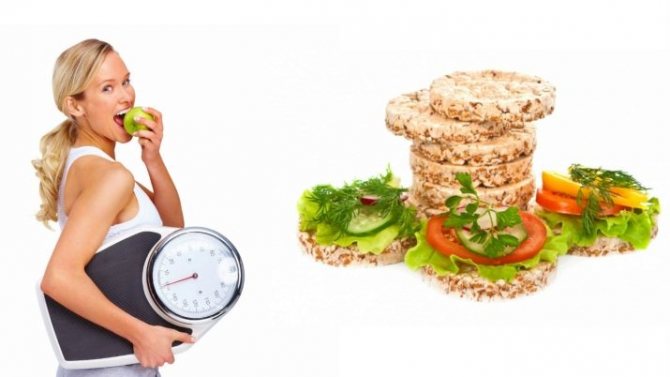
By adding healthy ingredients, the taste of the product improves. This product is perfect for a snack.
The calorie content of buckwheat bread is quite high. However, they can and even should be used in diets for weight loss. If you look at it, there are about 30 calories per loaf of bread, but this is quite a small amount. If you consume this product in moderation, it will not interfere with your weight loss diet.
Use of the ingredient in cooking
Most often, bread is used as an independent snack. They are eaten empty or with the addition of cream cheese, various sauces, meat, vegetables or fruits. But crispy sandwiches are not the only culinary use for bread.
Crushed dry bread can be used instead of breadcrumbs. Just wrap the bread in a bag and pass it around with a rolling pin several times; a more sophisticated option is to grind them in a blender. Ready-made buckwheat mixture is much healthier and more nutritious than regular breadcrumbs. The main thing is that the mixture is not inferior to breadcrumbs in terms of structural qualities and gives the dish more crunch and a pleasant buckwheat aftertaste.
Tip: You can add spices, chopped hard cheese or thick sauces to the buckwheat breading. Additional ingredients will make the mixture moister and more delicate in taste. Breaded bread dishes can be baked, pan-fried or deep-fried.
Crushed bread can be used as a base for both savory quiches and sweet cakes. The dry layer can be mixed with bananas, eggs, and spicy dressings to make the structure of the product softer and more moist inside. Don't worry that the base of the cake or pie won't match the filling. Try different combinations and find the perfect one that suits your taste.
Negative action
The benefits of the product are obvious, but harm is also possible. First of all, you should remember that although the product is absolutely suitable for dietary nutrition, it is still quite high in calories. Its calorie content per 100 grams is about 300 calories. In terms of the number of calories, you can put an equal sign between bread and yeast bread. However, unlike regular bread, the bread does not contain yeast, gluten, sugar or other ingredients. It is not necessary to completely replace bread with crispbread, but it is necessary to consume this product in moderation. Only then will it bring benefits without harm to the figure.
The presence of individual intolerance to buckwheat is an absolute contraindication for consumption.
Benefits of buckwheat flour
Buckwheat flour can be used without any problems when baking the same pies, pancakes, pancakes, buns and pies with fillings that are usually made from wheat flour. You can make delicious dietary dumplings using buckwheat flour.
You can make buckwheat flour yourself at home; it is a completely simple process. You will need to wash the buckwheat and then grind it in a food processor until it has a flour consistency. In the industrial production method, buckwheat is first peeled and only then ground into flour.
The benefits of buckwheat flour that you make at home and dishes from it are simply invaluable. Because you skip the process of dehulling the buckwheat grains, you'll end up with healthier bran flour than store-bought hulled flour. Remember that homemade buckwheat flour will differ from store-bought flour not only in its darker color, but also in its culinary qualities. Homemade buckwheat flour will be heavier when cooked than the same refined one.
But this will not in any way affect the benefits and calorie content of buckwheat flour. Buckwheat flour is an inexhaustible source of vegetable protein. Such a protein, containing all the necessary amino acids (lysine, threonine, etc.), is considered the healthiest food for our body. Low fat content and high fiber content makes buckwheat flour an indispensable product for a healthy, balanced diet.
Buckwheat flour contains very little sugar and carbohydrates; frequent consumption of buckwheat helps to quickly cleanse the body of toxins and other harmful substances. With an average calorie level (353 kcal), buckwheat flour is a common ingredient in the preparation of dietary dishes for people who suffer from diabetes. Buckwheat flour contains zinc, magnesium, potassium and iron, vitamins B, E, antioxidants and rutin. Ordinary wheat flour cannot boast even half of the beneficial properties that buckwheat flour has.
Features of eating buckwheat bread
The use of the product has certain characteristics, depending on the presence and nature of the current disease, human activity, and age.
For pancreatitis, gastritis, and ulcers, buckwheat bread can be consumed only with the permission of a doctor and no more than 100 g per day. In case of exacerbation of gastrointestinal diseases, diarrhea, or progressive constipation, they will have to be abandoned.
For children under 3 years of age, any bread is contraindicated because it harms digestion. The child's body is not able to digest such a high level of fiber.
The beneficial properties of buckwheat bread have a beneficial effect on the work of athletes’ muscles during intense training.
Pregnant women can replace some baked goods with buckwheat briquettes. The beneficial properties of folic acid will have a beneficial effect on the baby's intrauterine development. If constipation occurs, the number of breads should be reduced to 3 per day.
When breastfeeding, buckwheat bread can be gradually introduced into the diet. The main thing is not to exceed the recommended dose of 100 g and carefully monitor the baby’s reaction. If the baby has bloating, colic, or increased gas production, you will have to wait a little longer with the introduction of a new product after birth.
What are the benefits of citric acid, how to make it at home
People with diabetes should carefully read the label before purchasing. You can introduce buckwheat slices, devoid of sugar, into your diet. Useful daily allowance is no more than 100 g.
Important! A general recommendation when introducing buckwheat bread into your daily diet is to increase the amount of water consumed. Its deficiency can harm digestion, disrupt intestinal motility, and lead to constipation.
Beneficial features
Buckwheat bread combines not only nutritional value, but also usefulness. As a rule, vegetarians and athletes willingly include it in their daily diet. Buckwheat flour contains active natural compounds and a large amount of vitamins.
It is worth noting that buckwheat flour contains almost no gluten (gluten), so it is easily digestible. To prepare culinary products, it must be mixed with wheat flour, otherwise it will not be possible to replace the dough. Such a rich vitamin and mineral complex has a positive healing and cleansing effect on the human body.
Pure buckwheat bread recipe
To make bread from buckwheat flour without wheat you will need: one glass of warm milk or warm clean water, twenty grams of dry yeast with fast action, 1 tsp. sugar, half a glass of buckwheat flour, two eggs, 3 tablespoons of vegetable oil, one glass of corn starch.
Combine the yeast with sugar and warm liquid, add all the other ingredients, knead the dough thoroughly, cover with a towel and let the dough triple in size. Carefully place the baking sheet with the risen dough in the preheated oven for an hour. The oven must not be opened for the first forty minutes.
This type is completely gluten-free and has a lot of healing and beneficial properties:
- can be consumed by people with diabetes and allergies to gluten;
- has a positive effect on the functioning of the gastrointestinal tract;
- cleanses the walls of blood vessels, strengthening them;
- improves the functioning of the immune system;
- has a tonic effect;
- saturates the body with micronutrients, fiber, amino acids and vitamins.
The use of buckwheat flour in cosmetology
The product has a positive effect on a woman’s appearance, eliminating the formation of bags under the eyes and relieving puffiness. The easily digestible protein contained in the product can be beneficial and accelerate the growth of healthy and silky hair. In addition to internal use, the product is also used externally as masks to normalize the production of sebum, making the skin matte and fresh. Vitamin E in the product can stop the aging process of the skin.
Mask for oily skin
Unhealthy shine due to increased fat content is a fairly common women's problem, which should be combated not with chemicals and synthetic creams, but with useful folk remedies. To prepare the mask, boil dried chamomile. Combine it with buckwheat flour so that the mass comes out viscous and thick. Apply to face and rinse after 15-20 minutes
Moisturizing mask for dry skin
Dry facial skin is a serious problem that causes the appearance of wrinkles. To prepare a moisturizing mask, you need to place peeled and pitted plums in a food processor along with egg yolk, 1 tsp. honey and 1 tbsp. l. buckwheat flour. Distribute on face and rinse after 10-15 minutes.
Recommended reading: Benefits of white beans, properties and preparation
Film mask for sensitive skin
You can buy many synthetic film masks in stores, but a homemade folk remedy for sensitive skin is much better and will bring more benefits. To do this, combine 1 tbsp. l. gelatin with 100 ml of warm water or chamomile decoction. Add 1 more tbsp. l. buckwheat flour and mix. When the mixture has cooled, add 1 tbsp. l. aloe extract. Gently spread on face. After complete hardening, pull the edge of the resulting film and remove the mask.
Mask for oily hair
To get rid of unwanted oily hair, you can prepare a natural healthy mask at home. Fill the glass halfway with buckwheat flour and pour in the juice of half a lemon. Pour in milk and stir until smooth. Wash your hair with shampoo and only then use the mask. Comb your hair, wait 30 minutes and rinse using shampoo.
Harmful properties
Like any product, bread made using buckwheat flour is distinguished by the presence of not only useful, but also a number of harmful qualities. Despite the fact that the flour from which the product is made is practically incapable of causing allergic reactions, one should not forget about individual intolerance, which has the following manifestations:
- severe skin itching;
- swelling and redness of the eyes;
- stomach upset;
- nausea and severe vomiting;
- runny nose;
- in very rare cases, but still observed, suffocation.
In order not to feel all these negative consequences, you should initially try a small amount of a particular product. Only if there are no harmful manifestations can you consume the product in the desired quantity.
And also a significant amount of fiber can provoke increased gas formation in the intestines. For this reason, buckwheat bread is extremely undesirable for consumption by people who have recently undergone surgery, as well as by those who have problems with intestinal function.

The benefits and harms of buckwheat flour bread for weight loss
This bread is recommended for consumption by people suffering from excess weight. It is well absorbed, does not cause heaviness in the stomach, cleanses the gastrointestinal tract of harmful substances and effectively satisfies hunger. In addition, buckwheat bread has a low glycemic index, so it can be eaten if you have diabetes.
Read: Benefits of freeze-dried chicory
To get rid of excess weight, you need to choose a quality product and observe moderation in its use. You should not eat buckwheat bread containing large amounts of sugar, starch and various harmful additives, as this will lead to the opposite effect.
It should be borne in mind that abuse of this product not only contributes to obesity, but also increases the likelihood of the occurrence and development of various gastrointestinal diseases. In addition, excessive passion for such baking can lead to metabolic disorders and increased gas formation.
The benefits of buckwheat bread
When consumed regularly, buckwheat bread brings noticeable benefits: it improves the functioning of the pancreas, gall bladder, liver, kidneys, reduces cholesterol, and prevents the development of oncology.
Useful properties of buckwheat briquettes:
- High content of indigestible fiber. Coarse fibers have the property of cleaning the intestinal tract, like a brush. They eliminate toxins, prevent constipation, diarrhea, and stimulate salivation. During the breakdown of fiber, slow carbohydrates are produced, which provide a long-lasting feeling of fullness.
- Low glycemic index. The glycemic index of buckwheat bread is 45 points. This means that they quickly fill you up without causing sudden spikes in blood glucose.
- Gluten free. Recommended for people suffering from individual intolerance and allergies.
- High-quality and properly prepared bread does not contain salt, sugar, or yeast. These components cause significant harm to the figure, provoke indigestion, bloating, diarrhea, and can lead to swelling and allergic rashes. Braces containing exclusively whole grains are more beneficial for digestion.
Buckwheat breads contain about 52 g of slow carbohydrates. They promote a long-term feeling of satiety, normalize blood glucose levels, and reduce the amount of calories entering the body.
How to use buckwheat flour for medicinal purposes
Traditional medicine welcomes the prevention and treatment of various diseases with buckwheat flour. Our ancestors also used this product for their own purposes, and traditional healers added it to potions and healing mixtures.
Buckwheat flour for diabetics
The glycemic index of buckwheat flour is 54. This is a fairly low indicator that brings a long-lasting feeling of fullness due to the product’s ability to slowly reduce blood glucose levels. Therefore, many people with diabetes include it in their diet in the form of a medicinal mixture.
We recommend reading: What foods strengthen human bones: top 10 most useful ones that are needed in old age
To prepare it you need to mix 1 tbsp. l. buckwheat remedy in a glass of kefir and drink after meals for three months in a row.
Buckwheat flour for type 2 diabetes is used quite often to replace certain medications. To treat this disease, medications are prescribed that contain chiroinositol, which buckwheat flour also contains. It turned out that the majority prefer to be treated with natural products rather than resort to chemicals.
Buckwheat jelly for atherosclerosis
To prepare buckwheat jelly, place 250 ml of chilled drinking water in a separate container, combine it with three tablespoons of buckwheat flour and leave to infuse. In a deep saucepan, bring 1 liter of water to a boil and pour the soaked products into it and mix gently. After 15-20 minutes, remove from heat and add nuts or honey if desired.
For pancreatitis
To treat and prevent pancreatitis and other problems with the pancreas, you need to mix a glass of ground walnuts and buckwheat flour, pour honey over the ingredients and mix. Use 1 tablespoon before meals once a week.
To raise hemoglobin
A low hemoglobin level is a common problem that is best solved not by medication, but by the traditional method using the properties of natural remedies. To prepare the mixture, you need to combine walnuts and various dried fruits in equal quantities in a deep container. Ideally, use raisins, dried apricots and prunes. Pass all ingredients through a meat grinder or grind using a food processor. Add 2-3 tbsp buckwheat flour. l. and honey, mix well. Place the finished mixture in the refrigerator, eat a spoon three times a day after meals.
Buckwheat flour as a choleretic agent
It is necessary to prepare the choleretic remedy in the evening. Pour 1 tbsp into a glass of kefir. l. products and mix well. Place the drink in the refrigerator overnight. In the morning, drink kefir with buckwheat flour on an empty stomach, and an hour later have a hearty breakfast.
Cleansing and prevention of liver diseases
One of the safest ways to cleanse the liver of toxins, without nausea, diarrhea and other digestive problems, is to regularly consume buckwheat flour. The result will appear only after 10 days of using the product. Afterwards you need to take a break of 2 weeks. Such cleaning can be carried out no more than 4 times a year.
To prepare, you will need to combine a glass of low-fat kefir with 2 tbsp. l. buckwheat flour. Place in the refrigerator overnight and let the mixture brew. Eat as breakfast every morning. There is also a special diet based on buckwheat flour and kefir.
Composition and calorie content of buckwheat bread
The energy value calculated for 100 g of buckwheat bread is 280 - 300 kcal, depending on the manufacturer. For comparison, in white bread this figure reaches 260 points. However, the calorie content of 1 buckwheat bread weighing 10 g is less than 30 kcal, while a similar piece of white bread or loaf will harm your figure.
Crispbreads can harm your figure only if you significantly exceed the recommended norm, or if they are consumed together with high-calorie foods that do not have beneficial properties: jam, condensed milk, chocolate, fatty sour cream.
Despite their high calorie content, bread is a source of healthy fiber due to the content of whole grains. Buckwheat briquettes provide an adult with soluble and insoluble dietary fiber more than 40% of the daily requirement.
Buckwheat slices acquire beneficial properties due to their content:
- folic acid, which is involved in blood formation processes, prevents the occurrence of anemia and the growth of cancer cells; regulates the functioning of the heart muscle, blood vessels, and is responsible for immunity. Buckwheat plates contain 25 mg of the substance, which is 3% of a person’s daily requirement;
- iron, necessary for the production of hemoglobin, thyroid function, and metabolism. The product covers 4% of the daily requirement;
- vitamin PP, useful for the digestive tract, cardiovascular system, hormone production, tissue renewal. In addition, vitamin B3 promotes the production of hemoglobin and prevents the accumulation of cholesterol. The bread contains 5 mg of the substance, 3% of the daily value;
- vitamins B1, B6, B2, which have a beneficial effect on memory, immunity, excretory, digestive, endocrine systems, and the brain. In total, buckwheat product covers 10% of the adult body’s daily requirement for B vitamins.
Chickpeas: beneficial properties and contraindications
Crispbreads are rich in useful macro- and microelements transferred from buckwheat. They have a high content of magnesium, copper, manganese, zinc, phosphorus, potassium, and selenium.
Properties of buckwheat bread
Nutritional information | Vitamins | Minerals
How much does buckwheat bread cost (average price for 1 piece)?
Moscow and Moscow region.
60 rub.
People first began using such an important plant for all modern humanity as buckwheat in the cooking process over 5,000 years ago. It is noteworthy that India is considered the birthplace of buckwheat, from where the plant spread throughout Asia, and also the Middle East. Currently, the most widespread and cultivated plant species can be considered buckwheat or Fagópyrum esculentum.
Buckwheat, also called common or edible, refers to a species of herbaceous plants grouped into one family of the same name. Buckwheat is considered an important cereal crop. Various food products, including flour, are made from buckwheat. Healthy buckwheat bread and other baked goods are made from buckwheat flour. It is interesting that buckwheat bread is considered not only healthy, but also a nutritious food product.
As a rule, buckwheat bread contains wheat flour in addition to the flour of the same name. The calorie content of buckwheat bread may vary depending on the original composition of the ingredients used to prepare the baked product. And yet, the average caloric content of buckwheat bread is 228 kcal, which is per 100 grams of product.
What do buckwheat bread go with?
Buckwheat slices, due to their neutral taste, go well with almost any product, the benefits of which are beyond doubt among nutritionists: vegetables, meat, herbs, canned fish, caviar, cottage cheese, berries. Bread can be an excellent base for a sandwich. As a healthy snack, it goes harmoniously with drinks: compote, jelly, kefir, tea, cocoa, milk.
During diets, buckwheat slices can serve as the basis for delicious, nutritious desserts. For maximum benefit, you need to add nuts, dried fruits, and honey to the crushed briquettes.
Sources
- https://hudey.net/xleb-grechnevyj-poleznye-svojstva-i-kalorijnost.html
- https://poleznii-site.ru/pitanie/prochie-produkty/chem-polezny-grechnevye-hlebtsy.html
- https://FoodandHealth.ru/muchnye-izdeliya/hlebcy-grechnevye/
- https://health-diet.ru/table_calorie_users/804463/
- https://beregifiguru.ru/%D0%9F%D1%80%D0%BE%D0%B4%D1%83%D0%BA%D1%82%D1%8B/%D0%9A%D0%B0% D0%BB%D0%BE%D1%80%D0%B8%D0%B9%D0%BD%D0%BE%D1%81%D1%82%D1%8C/%D1%85%D0%BB%D0 %B5%D0%B1-%D0%B3%D1%80%D0%B5%D1%87%D0%B8%D1%88%D0%BD%D1%8B%D0%B9-128336
- https://FoodandHealth.ru/muchnye-izdeliya/hleb-grechneviy/
- https://eda-land.ru/krupy/grechka/hlebcy/
- https://eda-land.ru/krupy/grechka/hleb-polza-i-vred/
[collapse]

